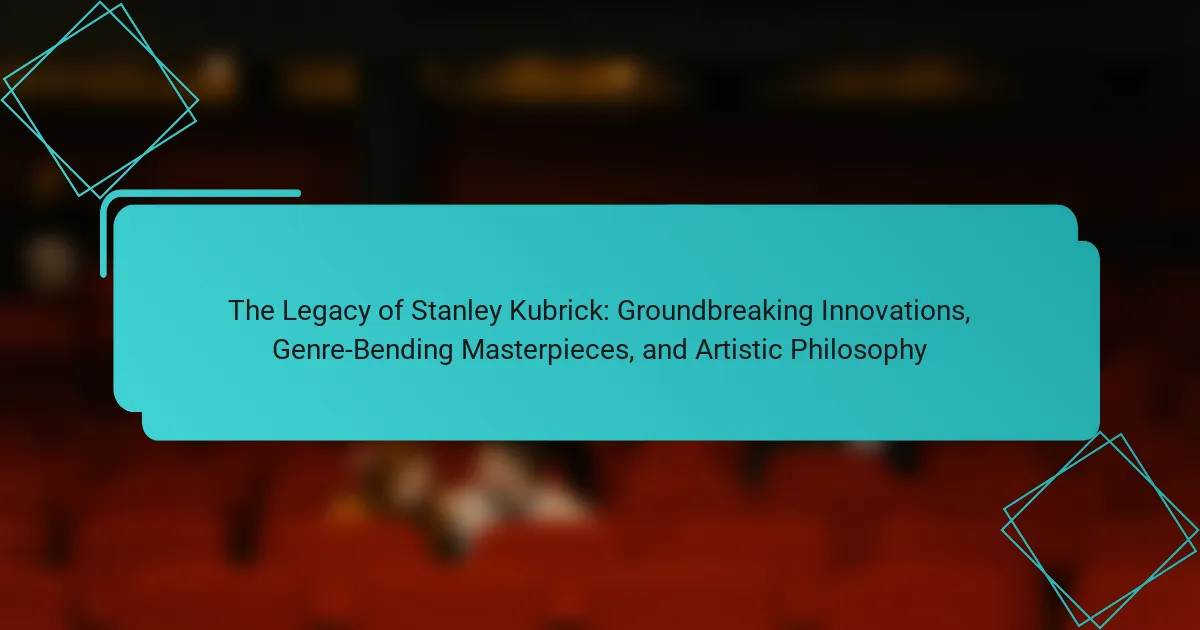Stanley Kubrick is a significant figure in cinema, known for his groundbreaking innovations and unique artistic philosophy. His films, such as “2001: A Space Odyssey” and “A Clockwork Orange,” are characterized by their exploration of complex themes, meticulous attention to detail, and pioneering use of technology. Kubrick’s approach to filmmaking emphasized visual storytelling and the blending of genres, influencing a wide range of filmmakers and artists. His legacy continues to shape modern cinema, as his techniques and thematic explorations remain subjects of study in film schools and critical discussions. This article examines Kubrick’s impact on filmmaking, highlighting his contributions to cinematography, production design, and narrative structure.

What is the legacy of Stanley Kubrick?
Stanley Kubrick’s legacy is defined by his innovative filmmaking techniques and profound impact on cinema. He pioneered the use of natural lighting and long takes, influencing cinematography standards. Kubrick’s films often explored complex themes, such as existentialism and human nature. Works like “2001: A Space Odyssey” and “A Clockwork Orange” challenged conventional narratives. His meticulous attention to detail set new benchmarks for production design and storytelling. Kubrick’s unique vision has inspired countless filmmakers and artists. His influence is evident in various genres, from science fiction to horror. Kubrick’s legacy endures through the continued study and appreciation of his work in film schools and critical discourse.
How did Stanley Kubrick influence the film industry?
Stanley Kubrick significantly influenced the film industry through his innovative techniques and unique storytelling. He pioneered the use of natural lighting and wide-angle lenses, which transformed cinematography. His meticulous attention to detail set new standards for production design. Kubrick’s films often explored complex themes, pushing the boundaries of genre. “2001: A Space Odyssey” redefined science fiction with its groundbreaking visual effects. His approach to narrative structure challenged conventional storytelling. Kubrick’s influence is evident in the works of many contemporary filmmakers. Directors like Christopher Nolan and Steven Spielberg cite him as a major inspiration.
What are the key films that define Kubrick’s legacy?
The key films that define Kubrick’s legacy include “2001: A Space Odyssey,” “A Clockwork Orange,” and “The Shining.” “2001: A Space Odyssey” is renowned for its groundbreaking visual effects and philosophical themes. Released in 1968, it revolutionized the science fiction genre. “A Clockwork Orange,” released in 1971, explores themes of free will and societal control, becoming a cultural touchstone. “The Shining,” released in 1980, is celebrated for its psychological horror and innovative cinematography. These films exemplify Kubrick’s mastery of storytelling and visual style. They have influenced countless filmmakers and continue to resonate with audiences today.
In what ways did Kubrick’s techniques change filmmaking?
Stanley Kubrick’s techniques fundamentally changed filmmaking through innovative use of technology and narrative structure. He pioneered the use of natural lighting in films like “Barry Lyndon,” which enhanced realism. Kubrick also employed long takes and meticulous framing to create tension and atmosphere. His nonlinear storytelling, as seen in “2001: A Space Odyssey,” challenged traditional narrative forms. Additionally, he utilized groundbreaking special effects, influencing visual storytelling in science fiction. Kubrick’s emphasis on psychological depth in characters redefined character development in cinema. His meticulous attention to detail set new standards for production design and cinematography. These techniques have left a lasting impact on filmmakers, inspiring new generations to explore creative boundaries.
What groundbreaking innovations did Stanley Kubrick introduce?
Stanley Kubrick introduced groundbreaking innovations in filmmaking techniques and narrative structure. He pioneered the use of natural lighting in films, notably in “Barry Lyndon,” which utilized candlelight for authenticity. Kubrick also advanced the art of tracking shots, exemplified in “A Clockwork Orange” with fluid, choreographed movements. His meticulous attention to detail set new standards for production design and visual storytelling. Kubrick’s use of music, particularly in “2001: A Space Odyssey,” redefined how sound could enhance narrative and emotion. His unconventional narrative structures challenged traditional storytelling, as seen in “The Shining.” Kubrick’s influence on special effects, especially in space scenes, pushed the boundaries of technology in cinema. Each of these innovations has left a lasting impact on the film industry.
How did Kubrick utilize technology in his films?
Stanley Kubrick utilized technology to enhance storytelling and visual impact in his films. He pioneered techniques such as the use of the Steadicam in “The Shining.” This technology allowed for smooth, fluid camera movements that intensified the viewer’s experience. Kubrick also employed practical effects and innovative lighting techniques. For example, in “2001: A Space Odyssey,” he used front projection to create realistic space environments. His meticulous attention to detail ensured that technology served the narrative. Kubrick’s collaboration with experts in various fields led to groundbreaking advancements in filmmaking. His films often featured cutting-edge sound design and visual effects that set new industry standards.
What unique storytelling methods did Kubrick employ?
Stanley Kubrick employed unique storytelling methods that included non-linear narratives and visual symbolism. His films often featured unconventional structures, challenging traditional storytelling. For example, “2001: A Space Odyssey” uses a fragmented timeline to explore themes of evolution and technology. Kubrick’s meticulous attention to visual detail created powerful imagery that conveyed deeper meanings. He frequently used long takes and static shots to build tension and immerse viewers in the atmosphere. Additionally, his use of music, such as in “A Clockwork Orange,” enhanced emotional impact and narrative depth. Kubrick’s innovative techniques have influenced countless filmmakers and continue to resonate in modern cinema.
What are the genre-bending masterpieces created by Stanley Kubrick?
Stanley Kubrick created several genre-bending masterpieces. Notable films include “2001: A Space Odyssey,” which blends science fiction with philosophical themes. “A Clockwork Orange” merges dystopian elements with dark comedy and social commentary. “The Shining” combines horror with psychological thriller aspects. “Dr. Strangelove” uniquely mixes political satire with black comedy. Each film showcases Kubrick’s innovative storytelling and visual style. These works have influenced numerous filmmakers and genres. Kubrick’s mastery lies in his ability to transcend traditional genre boundaries.
Which genres did Kubrick explore and redefine?
Stanley Kubrick explored and redefined several genres, including science fiction, horror, and war films. In science fiction, “2001: A Space Odyssey” introduced groundbreaking visual effects and philosophical themes. His horror film “The Shining” transformed the genre with psychological depth and unsettling imagery. Kubrick’s war film “Full Metal Jacket” provided a stark, unflinching portrayal of the Vietnam War. Each of these films challenged conventional storytelling and aesthetics, influencing future filmmakers and shaping genre expectations.
How did Kubrick’s films challenge traditional genre conventions?
Kubrick’s films challenged traditional genre conventions by blending elements from multiple genres. For example, “A Clockwork Orange” combines dystopian science fiction with dark comedy and psychological horror. This fusion creates a unique viewing experience that defies easy categorization. Additionally, “2001: A Space Odyssey” redefined science fiction by emphasizing philosophical themes over action and narrative structure. Kubrick often employed unconventional storytelling techniques, such as non-linear narratives and ambiguous endings. His meticulous attention to visual composition and sound design also set his work apart from typical genre films. Kubrick’s films often provoke deep thought, encouraging audiences to question societal norms and human nature. This approach has influenced countless filmmakers and continues to resonate in contemporary cinema.

What artistic philosophy guided Stanley Kubrick’s work?
Stanley Kubrick’s work was guided by a philosophy of meticulous craftsmanship and exploration of existential themes. He emphasized precision in filmmaking, often using extensive research and detailed planning. Kubrick believed in the power of visual storytelling, prioritizing imagery over dialogue. His films frequently delved into the darker aspects of human nature, questioning morality and society. This thematic focus is evident in works like “A Clockwork Orange” and “2001: A Space Odyssey.” Kubrick’s commitment to innovation is reflected in his pioneering use of technology and techniques in cinema. His artistic philosophy has influenced countless filmmakers and continues to resonate in modern cinema.
How did Kubrick’s personal beliefs shape his films?
Stanley Kubrick’s personal beliefs significantly influenced his films. His skepticism towards human nature is evident in many of his works. Kubrick often portrayed characters facing moral dilemmas and existential crises. This reflects his belief in the darker aspects of humanity. For instance, “A Clockwork Orange” explores themes of free will and violence. His fascination with technology and its impact on society is showcased in “2001: A Space Odyssey.” Kubrick’s anti-war sentiments are highlighted in “Full Metal Jacket.” He believed in questioning authority, which is a recurring theme in his films. Kubrick’s meticulous attention to detail also mirrors his belief in the power of visual storytelling. Each film serves as a reflection of his philosophical inquiries into life and existence.
What themes are prevalent in Kubrick’s filmography?
Kubrick’s filmography is marked by several prevalent themes. These include the exploration of human nature, the impact of technology, and the absurdity of existence. His films often delve into psychological horror and the darker aspects of humanity. Alienation and isolation are recurring motifs in works like “2001: A Space Odyssey” and “A Clockwork Orange.” Additionally, themes of war and violence are prominent in “Full Metal Jacket” and “Paths of Glory.” Kubrick frequently examines the struggle for power and control, as seen in “The Shining.” His films challenge viewers to confront moral ambiguity and ethical dilemmas. Overall, Kubrick’s thematic depth contributes significantly to his status as a cinematic innovator.
How did Kubrick’s philosophy influence his directorial style?
Kubrick’s philosophy significantly influenced his directorial style through meticulous attention to detail and a quest for perfection. He believed in the importance of visual storytelling. This belief led him to create striking imagery that often conveyed deeper meanings. His use of symmetry and composition became hallmarks of his films. Kubrick also valued the psychological depth of characters. This focus resulted in complex narratives that engaged audiences on multiple levels. Additionally, his philosophical inquiries into human nature shaped the themes of his films. Works like “2001: A Space Odyssey” reflect his exploration of existential questions. Overall, Kubrick’s philosophy drove his innovative techniques and thematic depth in cinema.
What role did collaboration play in Kubrick’s filmmaking process?
Collaboration was essential in Stanley Kubrick’s filmmaking process. He worked closely with various artists and technicians. This teamwork contributed to his innovative visual style. Kubrick often collaborated with cinematographers like John Alcott. Their partnership resulted in iconic cinematography in films like “Barry Lyndon.” He also engaged with composers, such as Wendy Carlos, to create unique soundscapes. Kubrick valued input from actors, enhancing performances through collaboration. His meticulous approach fostered a creative environment. This synergy led to groundbreaking films that pushed cinematic boundaries.
Who were the key collaborators that impacted Kubrick’s vision?
Stanley Kubrick’s key collaborators included cinematographer John Alcott and composer Alex North. John Alcott worked on films like “A Clockwork Orange” and “Barry Lyndon.” His cinematography significantly shaped Kubrick’s visual style. Alex North composed the score for “2001: A Space Odyssey,” enhancing its emotional depth. Other important collaborators were editor Ray Lovejoy and production designer Ken Adam. Ray Lovejoy’s editing contributed to the pacing and structure of Kubrick’s films. Ken Adam’s production design in “Dr. Strangelove” created iconic visuals. These collaborators played crucial roles in realizing Kubrick’s unique artistic vision.
How did Kubrick’s approach to collaboration differ from others?
Stanley Kubrick’s approach to collaboration was marked by a highly meticulous and controlling style. Unlike many directors, he often retained creative control over all aspects of production. Kubrick was known for his extensive pre-production planning. He would storyboard scenes in detail before filming began. This left little room for improvisation during shooting. His collaborators often described him as demanding and exacting. For example, he would require multiple takes to achieve his vision. This intense focus on detail sometimes strained relationships with actors and crew. However, it also led to groundbreaking cinematic achievements that defined his legacy.

How can filmmakers learn from Stanley Kubrick’s legacy?
Filmmakers can learn from Stanley Kubrick’s legacy by studying his meticulous attention to detail. Kubrick was known for his thorough research and preparation before filming. He often spent years developing a project, ensuring every aspect was meticulously planned. His use of innovative techniques, such as the Steadicam in “The Shining,” revolutionized cinematography. Filmmakers can also learn from his genre-blending approach, which combined elements from various styles to create unique narratives. Kubrick’s ability to provoke thought and challenge audiences remains a vital lesson. His films often explored complex themes, encouraging deeper engagement with viewers. By embracing these principles, filmmakers can enhance their own storytelling and artistic vision.
What lessons can be drawn from Kubrick’s innovative techniques?
Kubrick’s innovative techniques offer lessons in meticulous attention to detail and creative storytelling. His use of symmetry and framing enhances visual impact. The application of innovative camera techniques, such as the Steadicam, revolutionized movement in film. Kubrick’s commitment to authenticity in set design creates immersive worlds. His exploration of complex themes encourages deeper audience engagement. The use of music to enhance narrative tension is a hallmark of his style. Collaborating with skilled professionals across disciplines elevates the final product. These lessons underscore the importance of innovation and dedication in filmmaking.
Which best practices can modern filmmakers adopt from Kubrick?
Modern filmmakers can adopt several best practices from Stanley Kubrick. First, meticulous attention to detail is essential. Kubrick was known for his exhaustive research and preparation. This approach ensures authenticity and depth in storytelling. Second, innovative use of technology is crucial. Kubrick often pushed the boundaries of cinematic techniques, such as using special effects in “2001: A Space Odyssey.” Third, strong visual storytelling should be prioritized. Kubrick’s compositions are carefully crafted to enhance narrative. Fourth, embrace a collaborative environment with creative teams. Kubrick worked closely with actors, cinematographers, and designers to achieve his vision. Lastly, the exploration of complex themes can elevate a film. Kubrick’s works often delve into human psychology and societal issues. These practices can guide modern filmmakers in creating impactful cinema.
How can Kubrick’s artistic philosophy inspire new generations of filmmakers?
Kubrick’s artistic philosophy can inspire new generations of filmmakers through his commitment to meticulous craftsmanship. He emphasized the importance of detail in every aspect of filmmaking. This dedication is evident in his films, which often feature innovative cinematography and complex narratives. Kubrick’s willingness to challenge conventions encourages filmmakers to explore new storytelling techniques. His pursuit of authenticity in performances pushes directors to work closely with actors for deeper emotional resonance. Additionally, his exploration of philosophical themes invites filmmakers to engage with meaningful content. Kubrick’s legacy demonstrates that bold artistic choices can lead to groundbreaking cinema. His films continue to serve as a reference point for creativity and innovation in the industry.
The main entity of the article is Stanley Kubrick, a renowned filmmaker known for his groundbreaking innovations and genre-defining masterpieces. The article explores Kubrick’s legacy, highlighting his pioneering techniques in cinematography, narrative structure, and production design, as well as his exploration of complex themes such as human nature and technology. Key films like “2001: A Space Odyssey,” “A Clockwork Orange,” and “The Shining” are examined for their impact on the film industry and their challenge to traditional genre conventions. Additionally, the article discusses Kubrick’s artistic philosophy, collaborative process, and the lessons modern filmmakers can learn from his meticulous approach to filmmaking.
